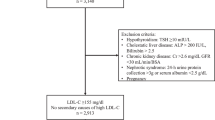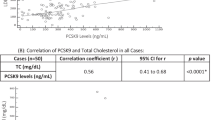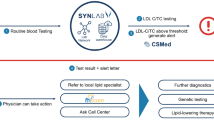Abstract
Current guidelines strongly recommend the identification of genetic forms of hypercholesterolemia (HC) during childhood. The usefulness of non–cholesterol sterols (NCS) in the diagnosis of genetic HC has not been fully explored. Plasma NCS were measured by gas chromatography/mass spectrometry (GC/MS) in 113 children with hypercholesterolemia affected by: autosomal dominant hypercholesterolemia (ADH), familial combined hyperlipidemia (FCHL), polygenic hypercholesterolemia (PHC), and in 79 controls to evaluate: i) plasma NCS profile in different genetic HC and ii) the usefulness of NCS for the diagnosis of HC beyond current clinical criteria. ADH was characterized by raised lathosterol/total cholesterol (TC) and reduced phytosterols/TC ratios, indicative of increased cholesterol synthesis. FCHL showed a slight increase of lathosterol/TC ratio, whereas PHC showed increased phytosterols/TC ratios, indicative of increased cholesterol absorption. In a post hoc discriminant analysis of patients with HC, lipid values correctly classified the 73% (14 of 19) of ADH, whereas the inclusion of plasma sterols allowed the correct identification of all 19 patients with ADH. FCHL was not differentiated from PHC (62 versus 69%). In conclusion, NCS measurement showed that cholesterol plasma levels are related to the cholesterol synthesis in ADH and to cholesterol absorption in PHC. NCS improve the detection of ADH in pediatric patients, whereas FCHL diagnosis is not improved.
Similar content being viewed by others
Log in or create a free account to read this content
Gain free access to this article, as well as selected content from this journal and more on nature.com
or
Abbreviations
- ADH:
-
autosomal dominant hypercholesterolemia
- FCHL:
-
familial combined hyperlipidemia
- HC:
-
hypercholesterolemia
- HeADH:
-
heterozygous ADH
- HoADH:
-
homozygous ADH
- NC:
-
normolipidemic controls
- PHC:
-
polygenic hypercholesterolemia
- TC:
-
total cholesterol
References
1991 Risk of fatal coronary heart disease in familial hypercholesterolemia. Scientific Steering Committee on behalf of the Simon Broome Register Group. BMJ 303: 893–896
Rahalkar AR, Hegele RA 2008 Monogenic pediatric dyslipidemias: classification, genetics and clinical spectrum. Mol Genet Metab 93: 282–294
Venkatesan S, Cullen P, Pacy P, Halliday D, Scott J 1993 Stable isotopes show a direct relation between VLDL apoB overproduction and serum triglyceride levels and indicate a metabolically and biochemically coherent basis for familial combined hyperlipidemia. Arterioscler Thromb 13: 1110–1118
Jaeger BR, Tsobanelis T, Bengel F, Schwaiger M, Seidel D 2002 Long-term prevention of premature coronary atherosclerosis in homozygous familial hypercholesterolemia. J Pediatr 141: 125–128
Kavey RE, Allada V, Daniels SR, Hayman LL, McCrindle BW, Newburger JW, Parekh RS, Steinberger J, American Heart Association Expert Panel on Population and Prevention Science American Heart Association Council on Cardiovascular Disease in the Young American Heart Association Council on Epidemiology and Prevention American Heart Association Council on Nutrition Physical Activity and Metabolism American Heart Association Council on High Blood Pressure Research American Heart Association Council on Cardiovascular Nursing American Heart Association Council on the Kidney in Heart Disease Interdisciplinary Working Group on Quality of Care and Outcomes Research 2006 Cardiovascular risk reduction in high-risk pediatric patients: a scientific statement from the American Heart Association Expert Panel on Population and Prevention Science; the Councils on Cardiovascular Disease in the Young, Epidemiology and Prevention, Nutrition, Physical Activity and Metabolism, High Blood Pressure Research, Cardiovascular Nursing, and the Kidney in Heart Disease; and the Interdisciplinary Working Group on Quality of Care and Outcomes Research: endorsed by the American Academy of Pediatrics. Circulation 114: 2710–2738
Brown AJ 2002 Atherosclerosis: cell biology and lipoproteins: cholesterol absorption inhibitors: gateway therapy for hypercholesterolemia. Curr Opin Lipidol 13: 701–703
Miettinen TA, Tilvis RS, Kesäniemi YA 1990 Serum plant sterols and cholesterol precursors reflect cholesterol absorption and synthesis in volunteers of a randomly selected male population. Am J Epidemiol 131: 20–31
Cohen JC, Pertsemlidis A, Fahmi S, Esmail S, Vega GL, Grundy SM, Hobbs HH 2006 Multiple rare variants in NPC1L1 associated with reduced sterol absorption and plasma low-density lipoprotein levels. Proc Natl Acad Sci USA 103: 1810–1815
Campagna F, Martino F, Bifolco M, Montali A, Martino E, Morrone F, Antonini R, Cantafora A, Verna R, Arca M 2008 Detection of familial hypercholesterolemia in a cohort of children with hypercholesterolemia: results of a family and DNA-based screening. Atherosclerosis 196: 356–364
Civeira F, Jarauta E, Cenarro A, García-Otín AL, Tejedor D, Zambón D, Mallen M, Ros E, Pocoví M 2008 Frequency of low-density lipoprotein receptor gene mutations in patients with a clinical diagnosis of familial combined hyperlipidemia in a clinical setting. J Am Coll Cardiol 52: 1546–1553
Ahmida HS, Bertucci P, Franzò L, Massoud R, Cortese C, Lala A, Federici G 2006 Simultaneous determination of plasmatic phytosterols and cholesterol precursors using gas chromatography-mass spectrometry (GC-MS) with selective ion monitoring (SIM). J Chromatogr B Analyt Technol Biomed Life Sci 842: 43–47
Bertolini S, Cantafora A, Averna M, Cortese C, Motti C, Martini S, Pes G, Postiglione A, Stefanutti C, Blotta I, Pisciotta L, Rolleri M, Langheim S, Ghisellini M, Rabbone I, Calandra S 2000 Clinical expression of familial hypercholesterolemia in clusters of mutations of the LDL receptor gene that cause a receptor-defective or receptor-negative phenotype. Arterioscler Thromb Vasc Biol 20: E41–E52
McCrindle BW, Urbina EM, Dennison BA, Jacobson MS, Steinberger J, Rocchini AP, Hayman LL, Daniels SR, American Heart Association Atherosclerosis Hypertension Obesity in Youth Committee American Heart Association Council of Cardiovascular Disease in the Young American Heart Association Council on Cardiovascular Nursing 2007 Drug therapy of high-risk lipid abnormalities in children and adolescents: a scientific statement from the American Heart Association Atherosclerosis, Hypertension, and Obesity in Youth Committee, Council of Cardiovascular Disease in the Young, with the Council on Cardiovascular Nursing. Circulation 115: 1948–1967
Starr B, Hadfield SG, Hutten BA, Lansberg PJ, Leren TP, Damgaard D, Neil HA, Humphries SE 2008 Development of sensitive and specific age- and gender-specific low-density lipoprotein cholesterol cutoffs for diagnosis of first-degree relatives with familial hypercholesterolemia in cascade testing. Clin Chem Lab Med 46: 791–803
Widhalm K, Dirisamer A, Lindemayr A, Kostner G 2007 Diagnosis of families with familial hypercholesterolemia and/or Apo B-100 defect by means of DNA analysis of LDL-receptor gene mutations. J Inherit Metab Dis 30: 239–247
Umans-Eckenhausen MA, Defesche JC, Sijbrands EJ, Scheerder RL, Kastelein JJ 2001 Review of first 5 years of screening for familial hypercholesterolemia in the Netherlands. Lancet 357: 165–168
Hedman M, Miettinen TA, Gylling H, Ketomäki A, Antikainen M 2006 Serum noncholesterol sterols in children with heterozygous familial hypercholesterolemia undergoing pravastatin therapy. J Pediatr 148: 241–246
Sudhop T, Lütjohann D, Kodal A, Igel M, Tribble DL, Shah S, Perevozskaya I, von Bergmann K 2002 Inhibition of intestinal cholesterol absorption by ezetimibe in humans. Circulation 106: 1943–1948
Ketomäki A, Gylling H, Siimes MA, Vuorio A, Miettinen TA 2003 Squalene and noncholesterol sterols in serum and lipoproteins of children with and without familial hypercholesterolemia. Pediatr Res 53: 648–653
Ketomaki A, Gylling H, Miettinen TA 2004 Effects of plant stanol and sterol esters on serum phytosterols in a family with familial hypercholesterolemia including a homozygous subject. J Lab Clin Med 143: 255–262
Zhao HL, Houweling AH, Vanstone CA, Jew S, Trautwein EA, Duchateau GS, Jones PJ 2008 Genetic variation in ABC G5/G8 and NPC1L1 impact cholesterol response to plant sterols in hypercholesterolemic men. Lipids 43: 1155–1164
García-Otín AL, Cofán M, Junyent M, Recalde D, Cenarro A, Pocoví M, Ros E, Civeira F 2007 Increased intestinal cholesterol absorption in autosomal dominant hypercholesterolemia and no mutations in the low-density lipoprotein receptor or apolipoprotein B genes. J Clin Endocrinol Metab 92: 3667–3673
Lapinleimu J, Nuotio IO, Lapinleimu H, Simell OG, Rask-Nissila L, Viikari JS 2002 Recognition of familial dyslipidemias in 5-year-old children using the lipid phenotypes of parents. The STRIP project. Atherosclerosis 160: 417–423
Cortner JA, Coates PM, Gallagher PR 1990 Prevalence and expression of familial combined hyperlipidemia in childhood. J Pediatr 116: 514–519
Author information
Authors and Affiliations
Rights and permissions
About this article
Cite this article
Noto, D., Cefalù, A., Barraco, G. et al. Plasma Non–cholesterol Sterols: A Useful Diagnostic Tool in Pediatric Hypercholesterolemia. Pediatr Res 67, 200–204 (2010). https://doi.org/10.1203/PDR.0b013e3181c8f035
Received:
Accepted:
Issue date:
DOI: https://doi.org/10.1203/PDR.0b013e3181c8f035
This article is cited by
-
Cholesterol metabolism in mice models of genetic hypercholesterolemia
Journal of Physiology and Biochemistry (2020)



